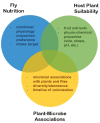The Protein Paradox: Elucidating the Complex Nutritional Ecology of the Invasive Berry Pest, Spotted-Wing Drosophila (Diptera: Drosophila suzukii)
- PMID: 38468895
- PMCID: PMC10926518
- DOI: 10.3389/finsc.2021.787169
The Protein Paradox: Elucidating the Complex Nutritional Ecology of the Invasive Berry Pest, Spotted-Wing Drosophila (Diptera: Drosophila suzukii)
Abstract
Spotted-wing drosophila (SWD), Drosophila suzukii, has become one of the most widely studied insect species over the last decade, largely due to its recent invasion and rapid expansion across the Americas and Europe. Unlike other drosophilid species, which colonize rotting fruit, SWD females possess a serrated ovipositor that allows them to lay eggs in intact ripening fruit, causing significant economic problems for fruit/berry producers worldwide. Though an impressive amount of research has been conducted on SWD's ecology and physiology, aspects of their nutritional ecology remain ambiguous. This review synthesizes the research to date to provide a more comprehensive view of SWD's nutritional relationship with its fruit hosts and associated microbes. Overall, data suggest that SWD's ability to utilize novel resources is likely due to changes in their ecological, rather than physiological, niche that are largely mediated by microbial associations. Studies show that SWD's nutrient intake is comparable to other drosophilid species, indicating limited adaptation to feeding on lower-protein resources. Instead, data show that fruit protein content is a reliable predictor of host suitability and that fruit-microbe dynamics have a strong impact on protein availability. In particularly, fruit protein increases after infestation with SWD-associated microbes, suggesting that initially-suboptimal intact fruits can become protein-rich on a timeframe that is relevant for larval nutrition. This body of work suggests that microbial associations between flies and their fruit hosts can compensate for the nutritional differences between intact and rotting fruit, and that these relationships are likely responsible for SWD's expanded nutritional niche.
Keywords: geometric framework; host suitability; macronutrients; microbes; niche.
Copyright © 2021 Deans and Hutchison.
Conflict of interest statement
The authors declare that the research was conducted in the absence of any commercial or financial relationships that could be construed as a potential conflict of interest.
Figures


Similar articles
-
Assessing Wine Grape Cultivar Susceptibility to Spotted Wing Drosophila and Melanogaster-Type Drosophila in Hungarian Vineyards: Effects of Berry Integrity and Insights into Larval Interactions.Insects. 2025 May 5;16(5):497. doi: 10.3390/insects16050497. Insects. 2025. PMID: 40429210 Free PMC article.
-
Nutrient-Dependent Impact of Microbes on Drosophila suzukii Development.mBio. 2018 Mar 20;9(2):e02199-17. doi: 10.1128/mBio.02199-17. mBio. 2018. PMID: 29559576 Free PMC article.
-
Economic analysis of revenue losses and control costs associated with the spotted wing drosophila, Drosophila suzukii (Matsumura), in the California raspberry industry.Pest Manag Sci. 2017 Jun;73(6):1083-1090. doi: 10.1002/ps.4497. Epub 2017 Jan 26. Pest Manag Sci. 2017. PMID: 27943618
-
Drosophila suzukii (Diptera: Drosophilidae): A Decade of Research Towards a Sustainable Integrated Pest Management Program.J Econ Entomol. 2021 Oct 13;114(5):1950-1974. doi: 10.1093/jee/toab158. J Econ Entomol. 2021. PMID: 34516634 Review.
-
Advances in the Chemical Ecology of the Spotted Wing Drosophila (Drosophila suzukii) and its Applications.J Chem Ecol. 2018 Oct;44(10):922-939. doi: 10.1007/s10886-018-1000-y. Epub 2018 Jul 27. J Chem Ecol. 2018. PMID: 30054769 Review.
Cited by
-
Propensity for resistance development in the invasive berry pest, spotted-wing drosophila (Drosophila suzukii), under laboratory selection.Pest Manag Sci. 2022 Dec;78(12):5203-5212. doi: 10.1002/ps.7139. Epub 2022 Aug 31. Pest Manag Sci. 2022. PMID: 36054242 Free PMC article.
-
Assessing Wine Grape Cultivar Susceptibility to Spotted Wing Drosophila and Melanogaster-Type Drosophila in Hungarian Vineyards: Effects of Berry Integrity and Insights into Larval Interactions.Insects. 2025 May 5;16(5):497. doi: 10.3390/insects16050497. Insects. 2025. PMID: 40429210 Free PMC article.
-
Low-Temperature Phosphine Fumigation Is Effective Against Drosophila suzukii in Sweet Cherry.Insects. 2025 Jun 17;16(6):635. doi: 10.3390/insects16060635. Insects. 2025. PMID: 40559065 Free PMC article.
-
The importance of time in nutrient regulation: a case study with spotted-wing Drosophila (Drosophila suzukii).Front Insect Sci. 2023 Jul 20;3:1105531. doi: 10.3389/finsc.2023.1105531. eCollection 2023. Front Insect Sci. 2023. PMID: 38469468 Free PMC article.
-
Effect of acetic acid bacteria colonization on oviposition and feeding site choice in Drosophila suzukii and its related species.bioRxiv [Preprint]. 2023 Mar 23:2023.03.20.533419. doi: 10.1101/2023.03.20.533419. bioRxiv. 2023. Update in: MicroPubl Biol. 2024 Feb 6;2024. doi: 10.17912/micropub.biology.001111. PMID: 36993389 Free PMC article. Updated. Preprint.
References
-
- Kanzawa T. Studies on Drosophila suzukii mats. J Plant Prot. (1936) 23:66–70.
-
- Kanzawa T. Studies on Drosophila suzukii Mats. Yamanashi, Kofu: Agricultural Experimental Station; (1939).
-
- Kaneshiro KY. Drosophila (Sophophora) suzukii (Matsumura). Proc Hawaiian Entomol Soc. (1983) 24:179.
-
- Toda MJ. Vertical microdistribution of Drosophilidae (Diptera) within various forests in Hokkaido. III The Tomakomai Experiment Forest, Hokkaido University. Res Bull College Exp Forests. (1987) 44:611–32.
-
- Oku T. SWD: Drosophila suzukii (Matsumura) in Japan. Agricultural Pest Encyclopedia Zenkoku Noson Kyoiku Kyokai P. (2003). p. 381.
Publication types
LinkOut - more resources
Full Text Sources
Molecular Biology Databases

